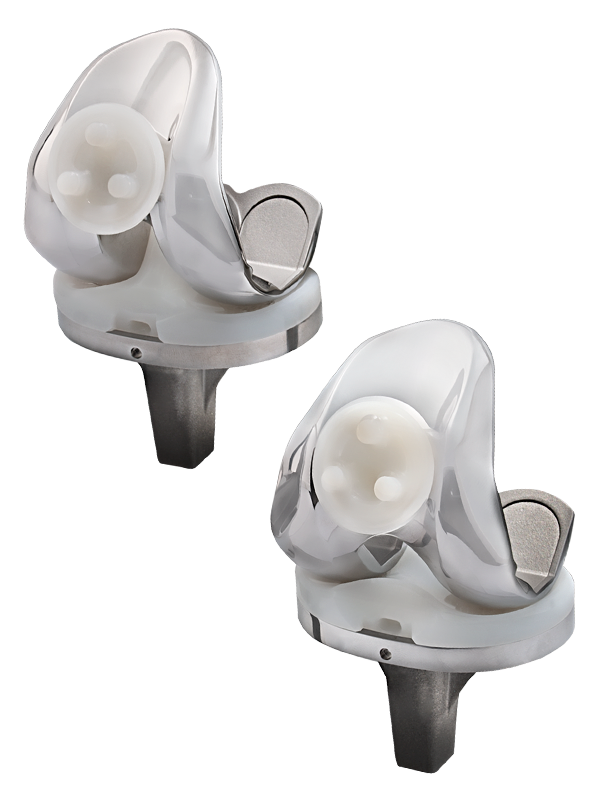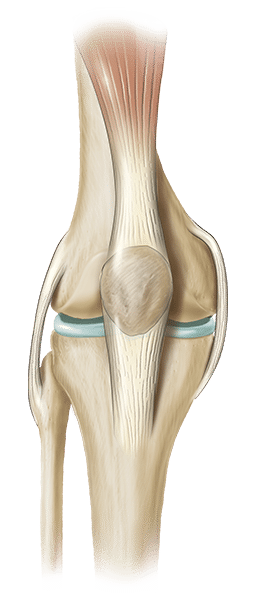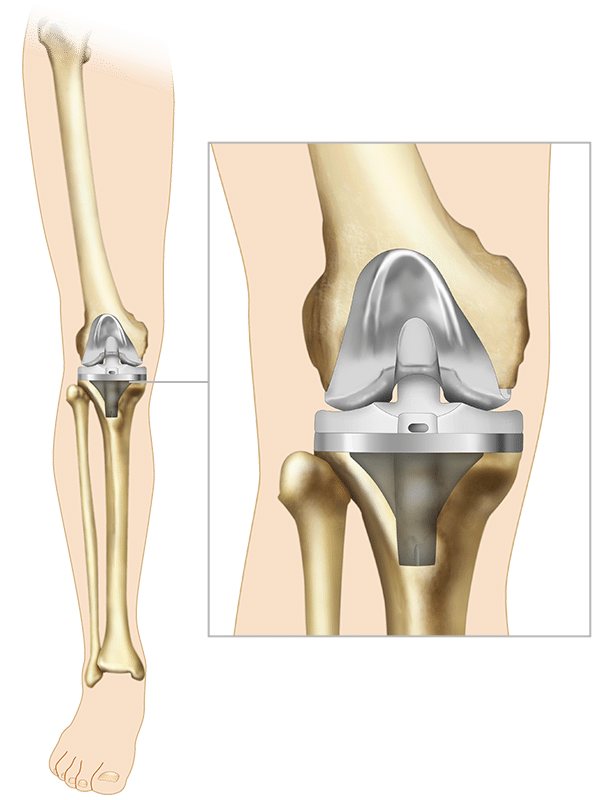Who does knee surgery in your area? Search by specialty and location to find a surgeon near you.
How Does Your Knee Work?
The knee is the largest joint in the body and is made up of the lower end of the thigh bone (femur), the upper end of the shin bone (tibia), and the knee cap (patella).
The surfaces where these three bones touch are covered with cartilage, a smooth substance that cushions the bones and allows them to move easily. Healthy cartilage lets you move your knee without pain when you walk, run or go up stairs.
All remaining surfaces of the knee are covered by a thin, smooth liner that releases a special fluid to lubricate the knee. This eliminates friction, or rubbing, almost completely in a healthy knee.
Normally, all of these components work in harmony. But disease or injury can disrupt this harmony, resulting in pain, muscle weakness and increased friction.
Osteoarthritis, the most common form of arthritis, is a condition that causes wear and tear to your joint cartilage. It develops after years of constant motion and pressure in the joints. As the cartilage continues to wear away, the joint becomes painful and difficult to move. If non-surgical treatment options, such as medication, physical therapy or lifestyle changes like losing weight, fail to provide relief, your surgeon may recommend total knee replacement surgery.
What is Total Knee Replacement Surgery?
Total knee replacement is a surgery to remove the damaged parts of your knee joint and replace them with new parts.
The word “replacement” may give the idea that your surgeon is removing the entire knee. But, they will only take out the damaged parts of your joint.
During knee replacement surgery, your surgeon will:
- Put you under anesthesia.
- Make a cut on the middle or side of your knee, so they can access your knee joint.
- Remove the damaged parts of your bones and/or cartilage.
- Replace those damaged parts with metal and plastic implants.
Knee Replacement Options
This type of surgery can have several benefits. It can:
- Let your surgeon access your knee joint with less trauma to your thigh muscles.
- Possibly limit your pain after surgery.
- Possibly shorten your recovery time.
During this type of surgery, your surgeon will:
- Use special surgical tools to prepare your thigh and shin bones.
- Make a small cut (4 to 6 inches).
- Remove the damaged parts of your bones and/or cartilage.
- Place a standard knee replacement implant through the incision.
After this type of surgery, you may stay in the hospital from one to four days. This is similar to how long you may stay after traditional knee replacement surgery.1
Minimally invasive knee surgery is not right for all patients. Talk to your doctor to see if this is a knee replacement option for you.
Advantages of outpatient surgery can include:
- Reduced hospital stay.
- Possible reduced chance of infection.
- Possible increased patient satisfaction.2
Ask your doctor if he or she is performing outpatient total knee replacement surgery and if you are a candidate.
To plan a traditional knee replacement, surgeons use X-rays, surgical tools and special techniques. With an Exactech Active Intelligence (AI) surgery, our technologies help your surgeon create your surgical plan and get more information they can use to make accurate and precise decisions about your shoulder replacement surgery.
Exactech AI technologies for knee replacement include:
- Newton® Knee Procedure
- ExactechGPS® Technology
- High-Tech Implant Materials
This interactive approach combines your surgeon’s expertise with the latest knee surgery technology. The result? A knee replacement personalized just for you.

Exactech Knee Replacement System
Exactech’s total knee replacement system is built on a history of knee implants that are clinically-proven and have performed well over time.4
The Exactech Knee system has many types and sizes of high-tech implants and can be used with the latest Exactech AI surgery technologies. So, your surgeon can tailor the knee implants to fit your body and make sure the surgery is precise, accurate and personalized just for you.
Some of the unique features of Exactech’s knee system include:
Advanced technologies may be used during your knee replacement surgery.
Ready to talk about joint replacement surgery with a doctor?
Search by specialty and location to find an orthopedic surgeon near you.
With any surgery, there are potential risks, and results will vary depending on the patient. Joint replacement surgery is not for everyone. Check with your physician to determine if you are a candidate for joint replacement surgery. Your physician will consider the risks and benefits associated with this procedure, as well as individual factors such as the cause of your condition, your age, height, weight and activity level.
The information contained within this website is for educational purposes only and is not providing medical advice. This information is not intended to replace the expert guidance of your orthopaedic surgeon. Please direct any questions or concerns you may have to your orthopaedic surgeon. Decisions concerning patient care and treatment should be made solely by your physician(s). With any surgery, there are potential risks and results will vary depending on the patient.
- Data on file at Exactech. 051K. Intercondylar Femoral Notch Preparation for Posterior Stabilized Knee Arthroplasty – Volumetric Bone Resection According to Two Methods.
- American Association for Hip and Knee Surgeons. Outpatient Hip or Knee Replacement. https://hipknee.aahks.org/outpatient-hip-or-knee-replacement/
- Data on file at Exactech.*
- Robinson RP, Green TM. Eleven-year implant survival rates of the all-polyethylene and metal-backed modular Optetrak posterior stabilized knee in bilateral simultaneous cases. J Arthroplasty. 2 011 Dec; 2 6 (8):116 5 -9.
- Edwards J, Gradisar I Jr, Nadaud M, Kovacik M, Askey M. Eight and one-half year clinical experience with the Optetrak total knee prosthesis. Presented at the American Academy of Orthopaedic Surgeons. February 2004.
- Furman, B.D., Bhattacharyya, S., Li, S. A Comparison of Degradation of UHMWPE for Shelf Aged and Implanted UHMWPE Components. Trans. 27th Ann. Meeting Soc. Biomaterials, 459, 2001.
*In vitro (bench) test results may not necessarily be indicative of clinical performance
ExactechGPS® is manufactured by Blue Ortho® and distributed by Exactech.


